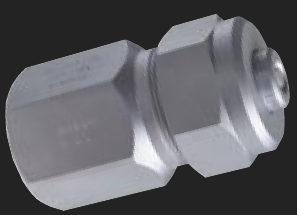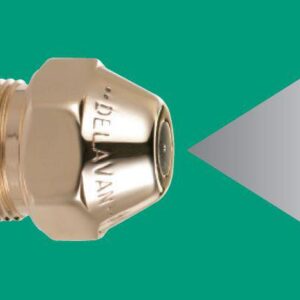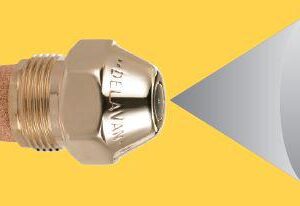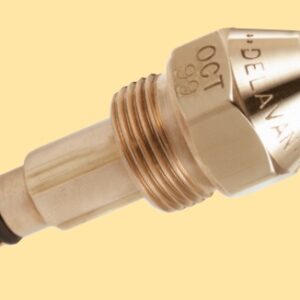Swirl-Air™ – Combustion Air Atomizing Nozzles
Spray Characteristics
Air, steam, or even a process gas, is introduced tangentially into the nozzle chamber in the low pressure region of the swirling mixture, creating extreme turbulence and primary atomization. As the fuel leaves the orifice, it impinges against the deflector ring which serves a dual purpose: close control of spray angle and breakup of the spray into even finer droplets (secondary atomization). Upon leaving the nozzle, the mixture swirls in a clockwise direction, looking downstream.
The nozzle has demonstrated the capability of achieving mean droplet diameters in the 50 to 100 micron range at modest air pressures and air volumes (SCFM). When using stream instead of air, the steam pressure should be approximately four times greater to achieve the same Spray Characteristics. Comparable atomization in a hydraulic nozzle would usually require very high fuel pressures. The degree of atomization is also fuel pressures. The degree of atomization is also variable by controlling the ratio of air to fuel flows.
Delavan's two-fluid Swirl-Air™ is designed to make maximum use of input hydraulic and pneumatic energy to atomize fuels at low pressures. In combustion Applications it can produce fine atomization at flow rates up to 300gph
Fuel enters the mixing chamber axially coming in contact with tangentially introduced streams of air (or steam). Interaction of the two creates extreme turbulence and mixing. Finally the fuel-air mixture impinges against a circular deflector ring, or pintle plate, before leaving the nozzle as a finely atomized spray.
Design of the pintle plate support eliminates the need for external struts that could interfere with the spray pattern. The progressive application of shear and inertial forces within the nozzle helps to provide high nozzle efficiencies.
Swirl-Air™ Advantages
- Large fuel passages and lack of torturous paths reduce chances for clogging.
- Air consumption (SCFM) and power requirements are relatively low, permitting the use of smaller, more economical, air compressors and blowers.
- Good atomization ratios
- Nozzle configuration provides vortex mixing of two fluids.
- Can handle fuels up to Type C Bunker oil...also combustible waste liquids. (The use of Swirl-Air™ nozzles in burning Bunker oils often reduces the accumulation of ashes caused by the high concentrations of impurities such as vanadium and sulphur).
- Various spray angles and capacities available through a selection of metering sets and swirl chambers.
- No external struts that interfere with the spray
Applications
The list of industrial combustion Applications for the Swirl-Air™ nozzle continues to grow. Here are some of the more common ones:
- As igniter nozzles in both coal-fired and oil-fired electric power stations.
- As main atomizers in large burners, especially where heavier fuels are used. Advantages include one or more of the following: Fewer flue deposits (ashes), lower smoke reading (0 Bacharach not uncommon), higher CO2 and lower pre-heat temperatures.
- As in incineration atomizer: Products such as waste water, mustard gas, chemical wastes, eggs etc, have been handled successfully.
Construction and Materials
Four-Piece construction:
- Nozzle body (adaptor)
- Swirl chamber
- Metering set (integral nut and pintle)
- Nozzle cap
Parallel and concentric bodies (adaptors) are available. Both are shown in the dimensional drawings.
Standard nozzle material is mild steel for all four basic parts. Other materials available on special request.
Considerations before Ordering
With a wide variety of combustion Applications, there is no way to cover all possibilities in one piece of literature. There are, for example, the problems of nozzle fixtures, the adaptations necessary for existing fireheads, and the needs for special adaptors. So if yours is such an application, send us the details and we will give you our recommendation. Use the following list of questions as your guideline:
- What type of fuel (#2, #4, #6 oil etc)
- Required flow rate in gallons per hour?
- What atomizing fluid...air, stream or other?
- What atomizing fluid pressure (psig) is available)
- What atomizing fluid volume (scfm) is available?
- What fuel pressure (psig) is avialable
- What is the method of attaching both fuel and atomizing fluid lines to the nozzle? Parallel pipes? Pipe within a pipe? Or other?
- Fuel pipe size?
- Atomizing fluid pipe size?
- Approximate spray angle required?
- If possible, also furnish prints of exiting Installation, or a free-hand sketch.
Manufactured in the UK
Delavan's two-fluid Swirl-Air™ is designed to make maximum use of input hydraulic and pneumatic energy to atomize fuels at low pressures. In combustion Applications it can produce fine atomization at flow rates up to 300gph
Fuel enters the mixing chamber axially coming in contact with tangentially introduced streams of air (or steam). Interaction of the two creates extreme turbulence and mixing. Finally the fuel-air mixture impinges against a circular deflector ring, or pintle plate, before leaving the nozzle as a finely atomized spray.
Design of the pintle plate support eliminates the need for external struts that could interfere with the spray pattern. The progressive application of shear and inertial forces within the nozzle helps to provide high nozzle efficiencies.
Swirl-Air™ Advantages
- Large fuel passages and lack of torturous paths reduce chances for clogging.
- Air consumption (SCFM) and power requirements are relatively low, permitting the use of smaller, more economical, air compressors and blowers.
- Good atomization ratios
- Nozzle configuration provides vortex mixing of two fluids.
- Can handle fuels up to Type C Bunker oil...also combustible waste liquids. (The use of Swirl-Air™ nozzles in burning Bunker oils often reduces the accumulation of ashes caused by the high concentrations of impurities such as vanadium and sulphur).
- Various spray angles and capacities available through a selection of metering sets and swirl chambers.
- No external struts that interfere with the spray
Applications
The list of industrial combustion Applications for the Swirl-Air™ nozzle continues to grow. Here are some of the more common ones:
- As igniter nozzles in both coal-fired and oil-fired electric power stations.
- As main atomizers in large burners, especially where heavier fuels are used. Advantages include one or more of the following: Fewer flue deposits (ashes), lower smoke reading (0 Bacharach not uncommon), higher CO2 and lower pre-heat temperatures.
- As in incineration atomizer: Products such as waste water, mustard gas, chemical wastes, eggs etc, have been handled successfully.
Construction and Materials
Four-Piece construction:
- Nozzle body (adaptor)
- Swirl chamber
- Metering set (integral nut and pintle)
- Nozzle cap
Parallel and concentric bodies (adaptors) are available. Both are shown in the dimensional drawings.
Standard nozzle material is mild steel for all four basic parts. Other materials available on special request.
Considerations before Ordering
With a wide variety of combustion Applications, there is no way to cover all possibilities in one piece of literature. There are, for example, the problems of nozzle fixtures, the adaptations necessary for existing fireheads, and the needs for special adaptors. So if yours is such an application, send us the details and we will give you our recommendation. Use the following list of questions as your guideline:
- What type of fuel (#2, #4, #6 oil etc)
- Required flow rate in gallons per hour?
- What atomizing fluid...air, stream or other?
- What atomizing fluid pressure (psig) is available)
- What atomizing fluid volume (scfm) is available?
- What fuel pressure (psig) is avialable
- What is the method of attaching both fuel and atomizing fluid lines to the nozzle? Parallel pipes? Pipe within a pipe? Or other?
- Fuel pipe size?
- Atomizing fluid pipe size?
- Approximate spray angle required?
- If possible, also furnish prints of exiting Installation, or a free-hand sketch.
Manufactured in the UK
Delavan's two-fluid Swirl-Air™ is designed to make maximum use of input hydraulic and pneumatic energy to atomize fuels at low pressures. In combustion Applications it can produce fine atomization at flow rates up to 300gph
Fuel enters the mixing chamber axially coming in contact with tangentially introduced streams of air (or steam). Interaction of the two creates extreme turbulence and mixing. Finally the fuel-air mixture impinges against a circular deflector ring, or pintle plate, before leaving the nozzle as a finely atomized spray.
Design of the pintle plate support eliminates the need for external struts that could interfere with the spray pattern. The progressive application of shear and inertial forces within the nozzle helps to provide high nozzle efficiencies.
Swirl-Air™ Advantages
- Large fuel passages and lack of torturous paths reduce chances for clogging.
- Air consumption (SCFM) and power requirements are relatively low, permitting the use of smaller, more economical, air compressors and blowers.
- Good atomization ratios
- Nozzle configuration provides vortex mixing of two fluids.
- Can handle fuels up to Type C Bunker oil...also combustible waste liquids. (The use of Swirl-Air™ nozzles in burning Bunker oils often reduces the accumulation of ashes caused by the high concentrations of impurities such as vanadium and sulphur).
- Various spray angles and capacities available through a selection of metering sets and swirl chambers.
- No external struts that interfere with the spray
Applications
The list of industrial combustion Applications for the Swirl-Air™ nozzle continues to grow. Here are some of the more common ones:
- As igniter nozzles in both coal-fired and oil-fired electric power stations.
- As main atomizers in large burners, especially where heavier fuels are used. Advantages include one or more of the following: Fewer flue deposits (ashes), lower smoke reading (0 Bacharach not uncommon), higher CO2 and lower pre-heat temperatures.
- As in incineration atomizer: Products such as waste water, mustard gas, chemical wastes, eggs etc, have been handled successfully.
Construction and Materials
Four-Piece construction:
- Nozzle body (adaptor)
- Swirl chamber
- Metering set (integral nut and pintle)
- Nozzle cap
Parallel and concentric bodies (adaptors) are available. Both are shown in the dimensional drawings.
Standard nozzle material is mild steel for all four basic parts. Other materials available on special request.
Considerations before Ordering
With a wide variety of combustion Applications, there is no way to cover all possibilities in one piece of literature. There are, for example, the problems of nozzle fixtures, the adaptations necessary for existing fireheads, and the needs for special adaptors. So if yours is such an application, send us the details and we will give you our recommendation. Use the following list of questions as your guideline:
- What type of fuel (#2, #4, #6 oil etc)
- Required flow rate in gallons per hour?
- What atomizing fluid...air, stream or other?
- What atomizing fluid pressure (psig) is available)
- What atomizing fluid volume (scfm) is available?
- What fuel pressure (psig) is avialable
- What is the method of attaching both fuel and atomizing fluid lines to the nozzle? Parallel pipes? Pipe within a pipe? Or other?
- Fuel pipe size?
- Atomizing fluid pipe size?
- Approximate spray angle required?
- If possible, also furnish prints of exiting Installation, or a free-hand sketch.
Manufactured in the UK
Latest News
Keep up to date with the latest news from partners, events, our company and the wider industry.
Request a Consultation
Have questions about our spray-nozzles or fluid handling systems? Looking for help on a unique application? Need help with a budget estimate to determine overall equipment costs? Please don’t hesitate to reach out — we’d love to help.






